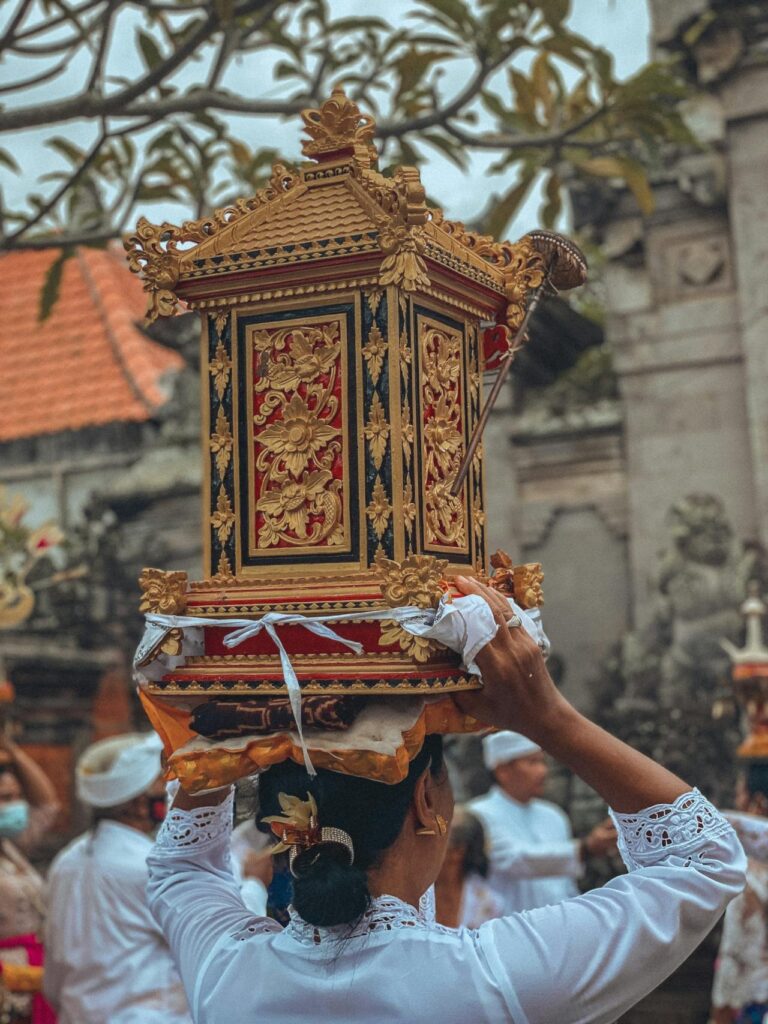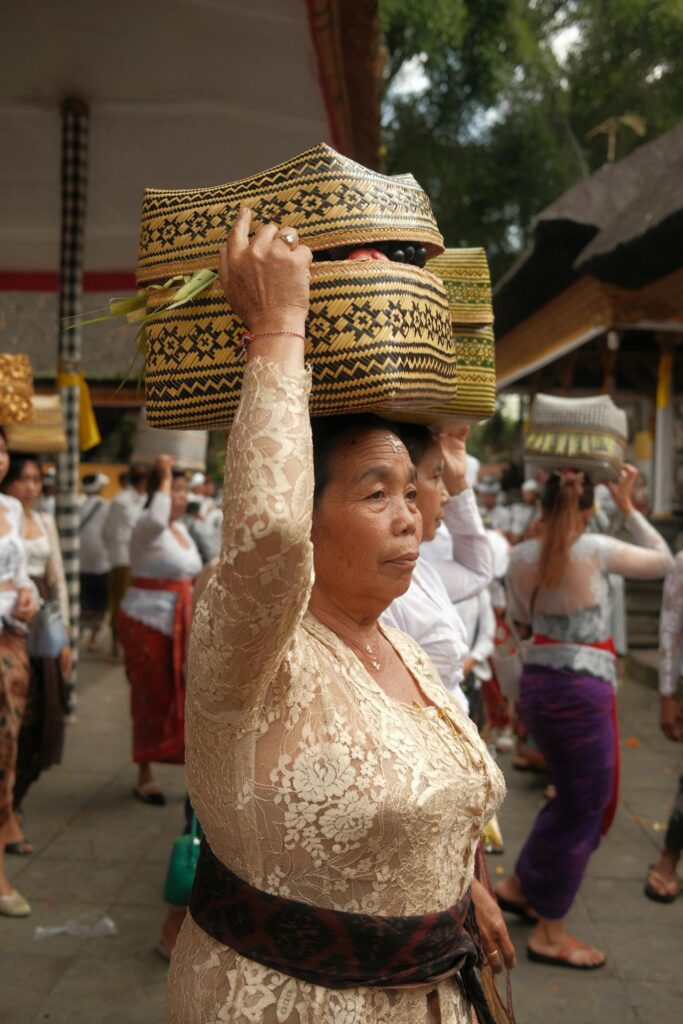Why Balinese Women Carry Offerings on Their Heads?
In the cultural heart of Bali, strength takes a unique and spiritual form. Observers, particularly foreigners and expatriates, are often left in awe at the sight of Balinese women balancing towering arrangements of offerings known as gebogan on their heads.
This spectacle, while seemingly extraordinary, is an everyday tradition that reflects the resilience, grace, and spiritual depth of Balinese Hindu culture.
The Strength of Woman in Bali, Indonesia
A recent viral video on TikTok, shared by the user @ekaftmwti, shows a Balinese woman carrying a 2-metre-high offering weighing approximately 50 kilograms.
@ekaftmwti Astungkara masih bisa melestarikan Budaya😇 #bali #budayabali ♬ Kamisan – Kroncong Jancuk
The video sparked admiration, with comments applauding the discipline, balance, and dedication of Balinese women:
“Balinese women with their customs and culture… Rahayu”
“Wow, that’s really tall! Balinese women are amazing, I’ve seen them carry these while riding motorbikes. It’s incredible how they carry them without holding on.”
What Is a Gebogan?
A gebogan, also referred to as pajegan, is an offering made in the form of a towering arrangement of fruit, snacks, and flowers. Balinese women play a central and integral role in the village community to make and bring the offerings.
These offerings are placed on a wooden tray known as a dulang, which becomes narrower at the top to aid in balance when carried on the head.
Gebogan are typically brought to temples during Hindu ceremonies as a form of gratitude to Ida Sang Hyang Widhi Wasa, the Supreme God in Balinese Hinduism.
The arrangement symbolises harmony and order. Fruits commonly used include bananas, apples, and pears, all carefully assembled and adorned with janur (young coconut leaves) and fresh flowers.
The aesthetic element is important, the conical shape and symmetrical design reflect the spiritual philosophy that underpins the offering: from the many below to the One above.
The Mapeed Culture
The act of carrying gebogan is part of a ceremonial culture known as mapeed, in which women walk in procession to the temple.
This procession usually occurs ten days after Galungan, a major Balinese festival. Aside from her regular household duties, a Balinese woman will spend a great amount of time making temple offerings and in ritual activities
Balinese girl wear matching Balinese kebaya and sarongs, with hair styled in a simple bun adorned with flowers. Mapeed is a communal expression of gratitude, humility, and reverence.

Most participants in mapeed are housewives, although they are often joined by husbands and children, all in traditional attire. The procession exemplifies gotong royong, or mutual cooperation, a cornerstone of Balinese society.
While the contents of gebogan were traditionally limited to local snacks and fresh produce, today they sometimes include modern packaged items.
However, there is ongoing discourse within the Balinese Hindu community regarding what is appropriate.
For instance, canned drinks are discouraged, as they are not considered satwika, or spiritually beneficial. Satwika food and drink are believed to positively influence body and soul, aligning with religious values.
As local traditions evolve with modernity, some regions face a decline in the availability of traditional snacks and fewer artisans capable of preparing them.
This shift reflects a broader concern about preserving cultural heritage amid practical changes.
Not About Competition, But Intention
One of the most profound aspects of gebogan is the sincerity behind it. While some gebogan may be taller or more elaborate, Balinese Hinduism discourages competition in this sacred tradition.
There is no requirement or pressure to create the most grandiose offering. What matters most is the intention behind the act, a sincere expression of gratitude and humility.
Gebogan is not judged by its height or extravagance, but by the heartfelt purpose of its creator. The practice teaches a valuable moral lesson: let us not compete to appear the greatest, but rather strive to embody humility and devotion.
A Living Heritage of Strength in Balinese Culture
The tradition of carrying gebogan on the head is deeply symbolic for the Balinese. It is considered a more respectful and grateful offering to God compared to carrying by hand.

The visual of Indonesian women walking long distances, sometimes riding motorcycles with gebogan atop their heads, showcases a unique blend of physical balance and spiritual discipline.
In addition to religious meaning, gebogan is also rich in aesthetic value. The artistic effort that goes into arranging each offering is a testament to Balinese craftsmanship and attention to detail.
Tourists are often drawn to the spectacle, although they are generally not permitted to enter the temple during the core rituals out of respect for the sanctity of the prayers.
Preserving Values Through Everyday Practices: The Role of Women and the People of Bali
Ultimately, gebogan reflects a philosophy of life that balances tradition, spirituality, relationship, and community that values deeply upheld by the people of Bali.
Central to this practice is the role of women, whose dedication, creativity, and discipline ensure the continuity of this cultural heritage.
In today’s fast-paced world, where the local often yields to the global, observing and honouring such traditions becomes even more meaningful.
Through the resilience and commitment of Balinese women, and the collective spirit of the people of Bali, the gebogan tradition invites us to reflect on our own connection to heritage, devotion, and humility.
Cover: Photo by Arjun Adinata/Pexels














































